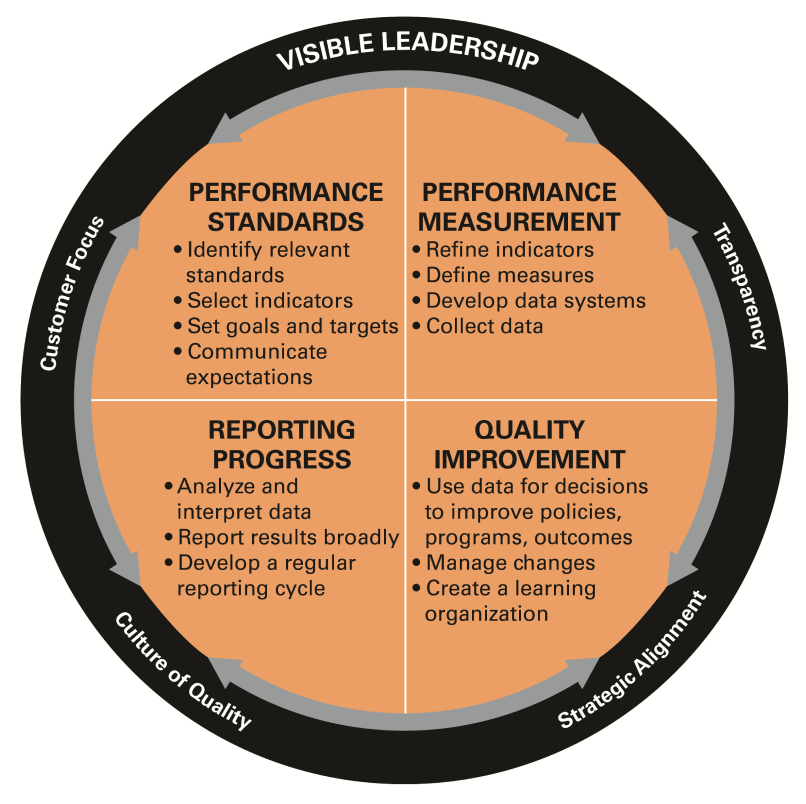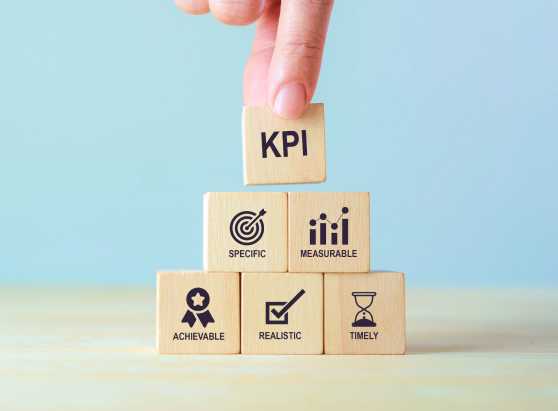Performance Management Toolkit

Welcome to the Public Health Performance Management Toolkit
A comprehensive Performance Management System (PM System) is vital to understanding how an organization is operating and functioning on a timely basis. The PM System should measure and monitor performance with scorecards and dashboards to track your organization’s key metrics.
QUICK LINKS

About the Performance Management System Framework
In 2002, the Public Health Foundation (PHF) was part of the Turning Point Performance Management National Excellence Collaborative (PMC), which developed a package of resource materials to help public health systems manage performance. Acknowledging advancements in the public health field, changing priorities, and the breadth of examples developed in recent years, PHF went through a two-year process to refresh the Turning Point Performance Management Framework in 2012 as part of a refresh effort by a collaborative, multidisciplinary think tank.
The updated Public Health Performance Management System Framework (shown here) depicts the practices by which performance management can be achieved. Continuous integration of these practices into the core operations of an organization enables performance management to produce long-lasting benefits. The core practices within the circle must be supported by visible leadership in order to sustain a culture of performance excellence.
The five components are defined as:
- Visible Leadership is the commitment of senior management to a culture of quality that aligns performance management practices with the organization’s mission, regularly takes into account customer feedback, and enables transparency about performance between leadership and staff.
- Performance Standards are the establishment of organizational or system standards, targets, and goals to improve public health practices. Standards may be set based on national, state, or scientific guidelines, benchmarking against similar organizations, the public’s or leaders’ expectations, or other methods.
- Performance Measurement is the development, application, and use of performance measures to assess achievement of performance standards.
- Reporting Progress involves documenting and reporting how standards and targets are met and sharing this information through appropriate feedback channels.
- Quality Improvement (QI) is the establishment of a program or process to manage change and achieve quality improvement in public health policies, programs, or infrastructure based on performance standards, measures, and reports.
Need Training or Technical Assistance?
Visible Leadership
- Transparency
- Strategic alignment
- Culture of quality
- Customer focus

Visible Leadership is the commitment of senior management to a culture of quality that aligns performance management practices with the organization’s mission, regularly takes into account customer feedback, and enables transparency about performance between leadership and staff.
In order to establish a long-lasting and sustainable performance management system at any organization, the senior management must commit to a culture that aligns performance management practices with the organization’s mission. Leaders must regularly take customer feedback into account to think about performance in context and with the end-user’s experience in mind. Additionally, leaders must enable transparency about performance throughout the organization.
Many organizations find it challenging to engage colleagues in performance management initiatives; capturing the interest of those in leadership roles may be even more difficult. Establishing and cultivating a commitment to performance management throughout the organization is crucial in building a culture of performance management that will lead to an enduring performance management system. Organizations should consider how their performance measures and reporting strategies connect to their ability to create interest and support among leadership. To successfully engage leadership, the following strategies may be helpful:
- Align performance management goals with current organizational strategic priorities.
- Share small performance management wins to illustrate how performance management works.
- Educate leaders about the potential of performance management to save the organization money and improve efficiency.
- Think about how you report progress and share data internally and externally to ensure that progress is clear, transparent, and easily noticed.
- Demonstrate how performance management can be used to make improvements throughout the year so that performance targets can be achieved.
- Don’t give up. Report positive progress and data as they become available and provide examples of how performance management has worked for other organizations.
Visible Leadership Resources:
A Complete Quality System Requires A Complete Leader
Share this article about the “Five Fatal Flaws to Leader Wholeness” with those in leadership who may be interested in building a performance management system for the organization.
Implementing the PDCA Cycle for Change Leaders, Understanding Your Leadership Style
Through this article, learn to understand and utilize leadership styles at the appropriate time and place to optimize your performance as a change leader to motivate and activate others to change.
Becoming a Complete Change Leader by Using Your Head, Heart, and Hands
This article explains how the Head, Heart, Hands, and Habit concept can enhance the Plan-Do-Check-Act (PDCA) cycle for change.
Performance Standards
- Identify relevant standards
- Select indicators
- Set goals and targets
- Communicate expectations

Performance Standards are the establishment of organizational or system standards, targets, and goals to improve public health practices. Standards may be set based on national, state, or scientific guidelines, benchmarking against similar organizations, the public’s or leaders’ expectations, or other methods.
To determine performance standards and targets, public health organizations and their partners can benefit from consulting national standards, state-specific standards, benchmarks from other jurisdictions, or organization-specific targets. The performance standards an organization chooses should reflect the organization’s strategic priorities and mission, as well as more specific goals articulated in documents such as the organization’s health improvement plan, workforce development plan, and quality improvement plan. Standards and targets can be “homegrown” or adapted from those being used by other organizations or recommended by programs, such as the Public Health Accreditation Board (PHAB) Standards and Measures and Healthy People.
Performance Standards Resources:
Public Health Accreditation Board (PHAB)
PHAB Standards and Measures may help a health department develop performance standards that are aligned with accreditation.
Healthy People
Healthy People provides a compilation of national health objectives and targets that health departments and others can use to develop their own performance standards.
Performance Measurement
- Refine indicators
- Define measures
- Develop data systems
- Collect data

Performance Measurement is the development, application, and use of performance measures to assess achievement of performance standards.
Choosing the correct performance measures is essential to performance management success. Public health organizations may consult national data sources and tools that include proven data sources and measures or develop their own procedures to measure performance. Each organization needs to identify the method of measurement that will work best in the context of their organization.
Public health organizations may want to keep several questions in mind when establishing and collecting performance measurement data. For example:
- Are there defined methods and criteria for selecting performance measures?
- Do quantitative measures have clearly established benchmarks for success?
- How is the data on the selected measures collected, and how often?
Through thoughtful consideration of both the measures and the mechanisms for collecting data about the measures, organizations can improve their performance management capacity.
One of the keys to using performance measurement to assess whether performance standards have been met is a dependable data collection process. The data should be reliable and clearly illustrate how well the performance standards are met as an indicator of whether a program or intervention is working. Organizations need to thoughtfully consider how to report the data most effectively, and to whom.
Performance Measurement Resources:
County Health Rankings
Ranking the health of nearly every county within individual states, the County Health Rankings measure the overall health (health outcomes) of each county in all 50 states and the District of Columbia, taking into account the many factors that influence health. It has been used to garner support among government agencies, healthcare providers, community organizations, business leaders, policymakers, and the public for local health improvement initiatives.
Health Department Survey Data: Association of State and Territorial Health Officials (ASTHO) and National Association of County and City Health Officials (NACCHO)
The Profile of State and Territorial Public Health (Profile) survey is a census conducted by ASTHO to gather information on state, territorial, and freely associated state public health agencies and their activities, structure, and resources. NACCHO’s infrastructure and systems programs create tools to build local health department infrastructure and systems; collect, analyze, and disseminate knowledge and insights from demonstration and pilot sites; lead trainings, informatics, and MAPP; and conduct research to strengthen local health department infrastructure by informing public policy and identifying needs.
Applying Performance Measurement to Public Health Policy Activities
Use this performance measurement tool developed by PHF and the American Public Health Association to develop performance measures for your policy activities. This tool offers an introduction to performance measurement within the context of performance management.
The National Indian Health Board (NIHB) and Public Health Indian Country Capacity Scan (PHICCS)
NIHB conducts the PHICCS every three years to assess the capacity of Tribal health and Tribal public health organizations delivering public health services. The PHICCS helps Tribes, Tribal organizations, partners, and policymakers better understand Tribal public health infrastructure and plan for future improvements.
PH WINS (the Public Health Workforce Interests and Needs Survey)
PH WINS supports the governmental public health workforce by measuring strengths and gaps to inform future investments in funding, training, recruitment, and retention. Conducted in 2014, 2017, and 2021 by the de Beaumont Foundation and the Association of State and Territorial Health Officials (ASTHO), PH WINS is the only nationally representative source of data about the governmental public health workforce.
TRAIN Learning Network and TRAIN Affiliates
TRAIN delivers training content and provides one-stop access to thousands of trainings from reputable organizations. TRAIN Affiliates, consisting of state, local, and Tribal health departments, can easily gather workforce data, manage training, design training plans to meet workforce needs, and conduct assessments and evaluations to ensure workforce development goals are met.
Reporting Progress
- Analyze and interpret data
- Report results broadly
- Develop a regular reporting cycle

Reporting Progress is the documentation and reporting of how standards and targets are met and the sharing of such information through appropriate feedback channels.
A public health organization should track and report progress depending on the goals of its performance management system and its intended uses of the data. When reporting progress, it is important to set criteria and goals for reporting based on the priorities of the organization or program. Choose to report about progress that will resonate with the priorities of those with whom you are sharing the report. For maximum effectiveness and impact, the progress reported should reflect trends over time.
A public health organization should track and report progress depending on the goals of its performance management system and its intended uses of the data. When reporting progress, it is important to set criteria and goals for reporting based on the priorities of the organization or program. Choose to report about progress that will resonate with the priorities of those with whom you are sharing the report. For maximum effectiveness and impact, the progress reported should reflect trends over time.
Effective reporting will reflect increased or sustained quality and provide insight into whether a program has been successful. When reporting progress, keep the following questions in mind:
- How does the organization or team document progress relate to meeting performance standards and targets?
- How, with whom, and when are reports about progress shared?
- Within the organization, who is accountable for collecting data about how well performance measures are met, and then reporting about these data?
Analysis and interpretation of data are critical components to developing a successful system for reporting progress to stakeholders. Reports about accomplishments and progress should be prepared so that data about progress are easy to understand and interpret. The frequency of reporting may vary depending on the initiative, and reporting progress does not refer exclusively to annual reporting. Many organizations find that offering progress updates at more regular intervals helps to engage leadership, make improvements to programs along the way, or even stick to project timelines.
Reporting Progress Resources:
Quality Improvement (QI) Graphic Tools To Help Us Understand Data
To achieve measurable improvements, we must have a systematic and continuous process of measuring and assessing the performance and outcomes of our products and services. To make improvements, it is essential for a health department to have a robust PM System that collects progress and performance data and presents it as information. This paper details the various QI tools to present data as information.
Quality Improvement
- Use data for decisions to improve policies, programs, and outcomes
- Manage changes
- Create a learning organization

Quality Improvement (QI) is the establishment of a program or process to manage change and achieve quality improvement in public health policies, programs, or infrastructure based on performance standards, measures, and reports.
Quality improvement in public health is the use of a deliberate and defined improvement process, such as Plan-Do-Check-Act, which is focused on activities that are responsive to community needs and improving population health. It refers to a continuous and ongoing effort to achieve measurable improvements in the efficiency, effectiveness, performance, accountability, outcomes, and other indicators of quality in services or processes which achieve equity and improve the health of the community. (Journal of Public Health Management and Practice 16(1):p 5-7, January 2010.)
In a performance management system, QI strategies should be integrated into ongoing progress monitoring. Additionally, as performance measures change, QI processes should be reassessed to ensure that they support efforts to meet performance standards. Successful QI is developed with a focus on related performance measures and data from periodic progress reports.
Quality Improvement Resources:
The ABCs of PDCA
This article is an introduction to the PDCA cycle, a QI method that improves processes and eliminates inefficiencies in health departments.
Key Ingredients in Public Health Quality Improvement
To support health departments’ efforts to implement QI, this guide lists factors that contribute to successful QI endeavors.
QI Quick Guide and Tutorial
The QI Quick Guide is a web-based guide that addresses a need identified by public health practitioners for assistance in determining which resources to use as they pursue QI initiatives. It includes a brief tutorial to help newcomers get started with QI concepts.
South Carolina's Quality Improvement Experience: Videos
These three educational videos about the QI experience feature the South Carolina Department of Health and Environmental Control and depict the importance of QI in performance management endeavors.
The Team Process Review Checklist
It is important to take a team approach to performance management. The Team Process Review Checklist can help you make sure essential items are in place for launching a team.
The Four Stages of Group Development
Teams can use this tool and the accompanying article to assess group development and identify the next steps for success.
The Public Health Quality Improvement Encyclopedia and Mobile App
The Public Health Quality Improvement Encyclopedia provides an overview of 75 QI tools and techniques for addressing QI questions and initiatives for any public health department. The Public Health Quality Improvement Encyclopedia is now available as a mobile app. Find it on the Apple App Store and Google Play Store!
Quality Improvement Tools to Advance Public Health Performance
This microsite houses many tools developed and refined by PHF, which have been categorized into QI tools for leadership development, team management, strategic planning, and several others.
Performance Management System PDCA Self-Assessment Tools – State and Local
There are two self-assessment tools, one designed for state health departments and the other designed for local health departments. Both are based on a model for performance management (PM) that follows a quality improvement (QI) cycle in which organization performance information and population outcome data are fed back into the system to improve future decisions. In this model, the main components of the PM System are Plan-Do-Check-Act (PDCA). The assessment questions are based on key types of alignment and select practices needed for a robust PM System.
TRAIN Learning Network Quality Improvement Resources
Use the TRAIN Learning Network to search for the newest Quality Improvement resources and training.
Need Training or Technical Assistance?
Contact Us
To share your feedback, suggestions, and resources, or to ask a question, contact PHF_Resources@phf.org.
The Public Health Foundation (PHF) collaborated with the Association of State and Territorial Health Officials (ASTHO) to develop the Performance Management Toolkit, specifically designed to address the performance management needs of Public Health Infrastructure Grant (PHIG) awardees.